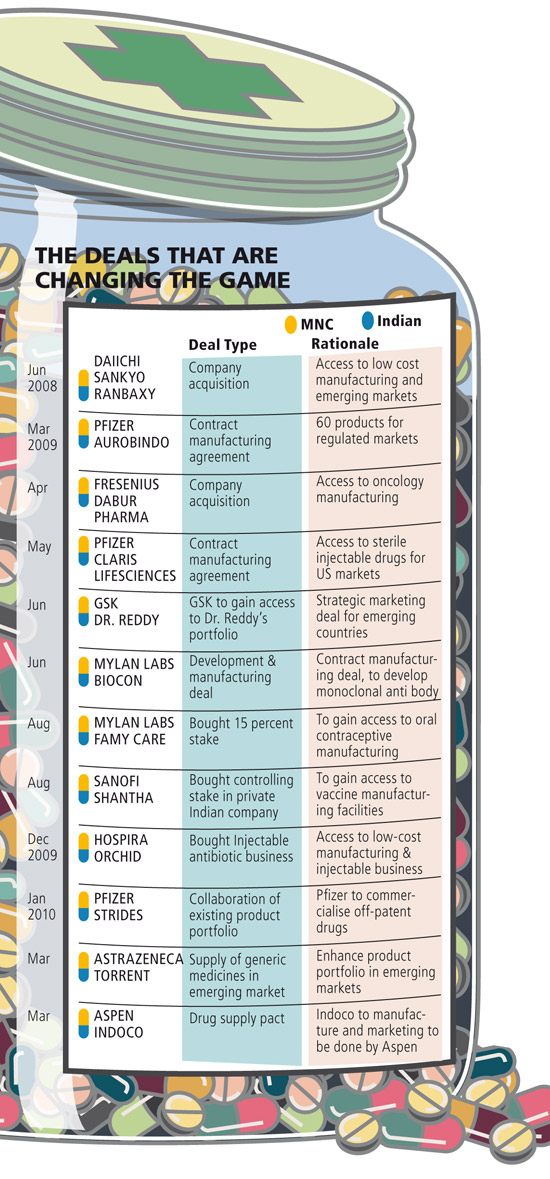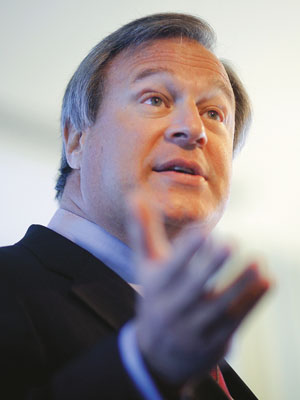
Indian Pharma's Second Life
Not long ago, innovator pharma companies considered Indian generic drug makers parasites. And then they had a change of heart
It was late evening in August 2008, Arjun Handa, then 28, vaguely recollects. He got a call from a senior executive from pharmaceutical major Pfizer’s Global Established Business Unit in New York, asking if he would like to meet up with their head. Handa’s first reaction was one of disbelief. Early into the conversation, he told the caller he was not interested in selling his family firm Claris Lifesciences. Shortly afterwards, Handa found that Pfizer’s business head David Simmons wanted to talk strategy — something Handa was fond of talking about.
Three years ago, this would have been unthinkable. Global pharmaceutical giants like New York-based Pfizer and Paris-headquartered Sanofi-Aventis, considered Indian drug firms parasites. Companies like Hyderabad-based Aurobindo Pharma and Ahmedabad-based Torrent, made copies of the costly-to-research patented medicines of the innovator firms and sold them cheap locally. These firms also fought court battles against the giant firms to disprove their patents.
The tide is now changing and how! In the last two years, the very firms who abhorred the Indian drug companies have inked around a dozen deals with them. Japanese firm Dai-ichi Sankyo set off the trend buying off India’s biggest pharmaceutical company, Delhi-based Ranbaxy Laboratories, in 2008. And now, big pharma companies will help Indian firms in distributing copies of international blockbusters medicines worldwide.The trend is significant for two reasons. Until now, a clear line demarcated the local firms and their overseas counterparts — the Indian firms sold cheap copies, while the MNCs hawked high quality originals. In the new scenario where aggressive firms like Pfizer and UK-based Astrazeneca are looking for deeper associations with local firms, the line has begun to blur. So the fortunes of the Indian firms will now entwine with the MNCs, which was not the case so far.
Second, the long term survival of medium- and small-sized drug firms seemed unsure as they did not have the financial might to set up an international marketing set-up like the big drug firms Ranbaxy, Dr. Reddy’s and Sun Pharmaceuticals. It looked as if Torrent and Aurobindo had missed the plot, as their balance sheet sizes did not give them room to invest big amounts in research and marketing.
Before the recent run on its stock, Torrent’s market capitalisation was $500 million, a tenth of Sun Pharma’s, though both the companies were of similar size in the late eighties. The opportunity to licence their drugs to multinational firms, to sell in regulated markets like the US and Europe and in emerging markets excluding India gives them a new revenue source.
Torrent’s market capitalisation has more than doubled as this opportunity became apparent. The sale of injectable drugs by Ahmedabad-based Claris Lifesciences to Pfizer will constitute a sixth of the Indian company’s sales within two years of the deal.
On their part, the MNC drug firms are committing big resources for their new business strategy. According to a local Pfizer executive, who did not wish to be named, the company has hired several top notch sales professionals to enlarge the team that sells injectable medicines that it buys from companies like Claris. In March, David Brennan, CEO of Astrazeneca told investors: “.. inclusion of branded generics in our portfolio.. can create a material business of some 10 to 15 percent of our emerging markets business by 2014.” Around the same time, Astrazeneca tied up with Torrent to source generic drugs (drugs that are no longer governed by patents and can be freely marketed by companies) and sell them in emerging markets.
Change of Heart
At first glance, big pharma’s move to sell cheaper generic medicines in the US couldn’t be better timed. President Barack Obama has pushed through reforms to make healthcare cheaper but has still not passed any strictures against the giant drug firms. This may well seem a pre-emptive action by the drug companies to do their bit by offering to sell cheaper medicines.
There are deeper reasons than that. Astrazeneca’s Brennan and his team formulated their all new generic strategy as early as 2004, well before Obama took charge. Recently in Nasik, Maharashtra to inaugurate a plant, GlaxoSmithKline’s (GSK) CEO Andrew Witty said, “We will sell specialised generics in global markets but don’t intend selling unbranded mass market generics.”
In 2006, Pfizer’s CEO Jeff Kindler surprised the healthcare world when he said that his firm will market off-patent drugs of his competitors through their sales network. In the last twelve months, Pfizer has inked deals in India and bid over $4 billion to buy out German generics player Ratiopharm in March 2010. Pfizer’s aggressive bid only emphasises the seriousness of big pharma to pursue their generic strategy.
The underlying reasons, of course, are purely commercial. Over the last decade, blockbuster drugs have been few and far in between and big drug firms have struggled hard to keep their growth momentum. Pfizer’s biggest growth came from its acquisitions rather than from the success of its research-based drugs. Today, one drug, the anti-diabetic Lipitor, contributes $12 billion to Pfizer’s annual sales but will go off-patent in 2012. It quickly needs other large new lines of business to supplement the loss of business from Lipitor.
Even as these tectonic shifts were happening within big pharma, generic firms led by Israel-based Teva and a clutch of Indian companies were growing rapidly. In the last decade, Teva’s sales has grown from $1 billion to $12 billion, with mass market generics contributing to two-thirds of its sales. Its $5 billion acquisition of Ratiopharm after a face-off with Pfizer, has made big pharma realise the growing importance of generics all over again.
 Illustration: Malay Karmakar
Illustration: Malay KarmakarOn the back of their generic business, the top five Indian companies are together valued upwards of $25 billion and have attracted top global investors like Mark Mobius and Morgan Stanley. “Indian firms are no longer small firms nibbling at MNC firms,” says D.G. Shah, secretary general of Indian Pharmaceutical Association, a body constituted of big local firms.
And finally, over the next five years, $80 billion worth of drugs are expected to go off-patent and that could alone translate into an opportunity of $5 billion — $10 billion for the industry. An industry estimate puts the market for off-patent medicines growing from $270 billion to $500 billion in the next few years, driven largely by emerging markets like China, India, Latin America and Russia. Y.K. Hamied, bete noire of big pharma for his cheap cancer drugs and chairman of India’s biggest domestic firm Cipla says, “MNCs now want to buy us out for research capabilities in the generic space and our large marketing setup.”
Booming fortunes
If the spurt in stock prices of firms like Torrent, Strides Arcolab and Aurobindo is anything to go by, investors are viewing the new opportunity for Indian firms in a favourable light. “This is a form of the contract manufacturing opportunity for Indian firms we have been talking about for a while now,” says Tarun Shah of Vadodara-based specialised pharma research MP Partners.
Glaxo’s Witty also outlined this opportunity. He was already looking at India as a sourcing base as the Nasik facility of Glaxo produces a third of the global volumes. It employs 700 people compared to an estimated 40,000 people on its rolls globally.
A senior executive in Aurobindo Pharma, who did not wish to be named, said that their deal was signed within six months after talks first started. This combined with cost effective manufacturing to play a vital role for Pfizer to sign the deal to market its solid dosage form (like tablets) drugs in the US. Handa of Claris says, “Indian companies are at least four years ahead of their Chinese counterparts as they started the process of acquiring regulatory approvals almost a decade ago.” Most of the deals are licensee agreements where the big pharmaceutical firms will buy drugs from Indian firms for a fixed amount, then brand and sell the formulations through their marketing network. Sundeep Bambolkar, director of finance and operations at Mumbai-based Indoco Remedies, a small-sized pharma firm feels there are three possible models for tie-ups. One, an outright sale of drugs by Indian companies at an agreed price. Two, cost plus margins in case of drugs with substantial volumes. Three, a cost-and-profit sharing model in cases where the foreign partner is willing to share the risk of getting approvals in tough regulatory models. He says that since Indoco earns better margins for the seven products its sells to South Africa based Aspen, it plans to step up research spending to 4 percent from the current 2.5 percent.
Despite the positive fervour, MP Partner Shah says that it is best to take a cautious note of this development. He says that the generic market is fraught will price reductions and margins squeezes. This could translate into MNCs getting in and out of products in line with market needs. “If Pfizer pulls out of a product or a therapy in due course, the fortunes of Indian companies can change overnight,” says Shah.
Shah’s concerns notwithstanding, the owners of Indian drug firms are in a buoyant mood right now. Glaxo’s Witty has earlier said that he would very much want to make an acquisition in the country soon.The head of the Glaxo’s India business, Hasit Joshipura says that no one is willing to sell now. “They want the moon,” he says.
(This story appears in the 30 April, 2010 issue of Forbes India. To visit our Archives, click here.)
-
 Vivek Hattangadi
Vivek HattangadiSun Pharma was still in its infancy stage in the late eighties - Torrent was 10 times larger than Sun Pharma. In fact, Dilip Shanghavi had bench-marked Torrent for its own progress.Eventually, in the mid-nighties, it grew as big as Torrent and by late nighties Sun Pharma dwarfed Torrent
on Dec 9, 2011















